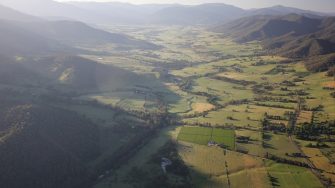
Date: Thursday, October 29, 2015
Project: Eastern Australian Waterbird Survey
Observer: Richard Kingsford
Up at dawn for a stunning flight over the King, Ovens, Kiewa and Mitta Mitta Rivers. The early morning sun and wisps of mist over the rivers were beautiful. And the plane wasn’t bouncing – what more could you ask for? We flew down each of the rivers in turn.
Surveying the Kiewa River early this morning.
They had water in the main channels but many of the flanking billabongs and lagoons were dry. There were only a few waterbirds which prefer the still water of wetlands, rather than the running rivers. Small flocks of straw-necked ibis were scattered around, feeding on the pastures.
The Kiewa River valley looking south from up high
Surveying the Mitta Mitta River
The Mitta Mitta River had a strong flow and we followed it all the way to where it is regulated by the huge Dartmouth Dam. This massive structure rises from the river, blocking the river’s path. Behind the dam wall, the water is stored for downstream communities, mainly irrigation industries all the way down the River Murray to South Australia.
Flying over the Dartmouth Dam wall on the Mitta Mitta River to survey the dam
The scar of dead trees around the edge marked the high water mark, showing that water levels were low, reflecting the poor rainfall year experienced. I saw no waterbirds on the great expanse of water, which is just too deep and unproductive for feeding waterbirds.
Low water levels in Dartmouth Dam, shown by the dead trees marking the high water mark of the dam.
The morning flight continued to be spectacular, as we ‘hopped’ over the Snowy Mountains with a few patches of snow on the brown ski slopes of Thredbo.
Another part of the Snowy Mountains Hydroelectricity Scheme was next – Jindabyne Dam. This is the dam that severely regulates river flows in the Snowy River which would have originally flowed out to sea but now gets diverted over the Great Dividing Range into the River Murray and Murrumbidgee River. Only 1% of flows used to make it down the Snowy until the Governments of New South Wales and Victoria with the Commonwealth decided to return more flows, up to a target of 21% which has yet to be reached.
Jindabyne Dam releasing environmental flows down the Snowy River
The dam is true to form as waterbird habitat, with only a few silver gulls and cormorants. Even in dry times, these dams do not function as drought refuges for waterbirds which was once thought.
On to the Monaro plains where a surprise waited for us in this dry year. These plains have about 30 small lagoons which are nearly always dry but not this year. They were teeming with waterbirds: grey teal, Australasian shoveler, pink-eared duck, hardhead, pied stilts and even a few swans nesting. This little patch of eastern Australia seems to be doing alright this year. They must have had a few good storms to fill up these shallow lagoons which are great for waterbirds.
Wetlands on the Monaro plain, near Cooma, were flooded with lots of waterbirds.
We finished off the survey at Brogo Dam on the Bega River and then headed back to Sydney. Next Wednesday – we head off down the River Murray to survey the wetlands at the Murray mouth.
